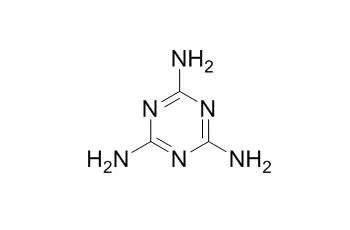| Description: |
Melamine is a widely-used intermediate, mainly employed as a raw material for producing melamine resin and is a chemical most often found in plastic materials.Melamine has nephrotoxic, the combination of melamine and cyanuric acid can cause acute renal failure in cats. The intumescent system additives( filled with ammonium polyphosphate, pentaerythritol and melamine) is an effective flame retardant on improving combustion properties for polypropylene. |
| In vitro: |
| Polymer, 1998, 39(10):1951-1955. | | Dynamic. Flame retardancy of polypropylene filled with ammonium polyphosphate, pentaerythritol and melamine additives[Reference: WebLink] | The dynamic flammability properties of an intumescent fire retardant polypropylene filled with ammonium polyphosphate, pentaerythritol and Melamine was discussed in this study.
METHODS AND RESULTS:
To evaluate the flammability properties of the materials, limit oxygen index, smoke emission, tensile strength, and our exploitation ‘dynamic flammability evaluation system’ tests were assessed in experiments. The results showed that the intumescent fire retardant filled polypropylene has superior flammability properties and keeps its mechanical strength. It also can be seen that CO concentration and smoke emission decrease while burning.
CONCLUSIONS:
It is concluded that this intumescent system additives is an effective flame retardant on improving combustion properties for polypropylene. |
|
| In vivo: |
| J Vet Diagn Invest. 2007 Nov;19(6):616-24. | | Assessment of melamine and cyanuric acid toxicity in cats.[Pubmed: 17998549 ] | The major pet food recall associated with acute renal failure in dogs and cats focused initially on Melamine as the suspect toxicant. In the course of the investigation, cyanuric acid was identified in addition to Melamine in the offending food. The purpose of this study was to characterize the toxicity potential of Melamine, cyanuric acid, and a combination of Melamine and cyanuric acid in cats.
METHODS AND RESULTS:
In this pilot study, Melamine was added to the diet of 2 cats at 0.5% and 1%, respectively. Cyanuric acid was added to the diet of 1 cat at increasing doses of 0.2%, 0.5%, and 1% over the course of 10 days. Melamine and cyanuric acid were administered together at 0%, 0.2%, 0.5%, and 1% to 1 cat per dose group. No effect on renal function was observed in cats fed with Melamine or cyanuric acid alone. Cats dosed with a combination were euthanized at 48 hours after dosing because of acute renal failure. Urine and touch impressions of kidneys from all cats dosed with the combination revealed the presence of fan-shaped, birefringent crystals. Histopathologic findings were limited to the kidneys and included crystals primarily within tubules of the distal nephron, severe renal interstitial edema, and hemorrhage at the corticomedullary junction. The kidneys contained estimated Melamine concentrations of 496 to 734 mg/kg wet weight and estimated cyanuric acid concentrations of 487 to 690 mg/kg wet weight.
CONCLUSIONS:
The results demonstrate that the combination of Melamine and cyanuric acid is responsible for acute renal failure in cats. |
|






 Cell. 2018 Jan 11;172(1-2):249-261.e12. doi: 10.1016/j.cell.2017.12.019.IF=36.216(2019)
Cell. 2018 Jan 11;172(1-2):249-261.e12. doi: 10.1016/j.cell.2017.12.019.IF=36.216(2019) Cell Metab. 2020 Mar 3;31(3):534-548.e5. doi: 10.1016/j.cmet.2020.01.002.IF=22.415(2019)
Cell Metab. 2020 Mar 3;31(3):534-548.e5. doi: 10.1016/j.cmet.2020.01.002.IF=22.415(2019) Mol Cell. 2017 Nov 16;68(4):673-685.e6. doi: 10.1016/j.molcel.2017.10.022.IF=14.548(2019)
Mol Cell. 2017 Nov 16;68(4):673-685.e6. doi: 10.1016/j.molcel.2017.10.022.IF=14.548(2019)